If you are planning a trip to Krakow, you cannot miss a visit to the Wieliczka Salt Mine, one
of the most popular tourist destinations in Poland. Located just a short distance from the city,
the Wieliczka Salt Mine is a unique attraction that offers visitors a fascinating glimpse into
the history of salt mining and the daily life of miners.
About the Wieliczka Salt Mine
The Wieliczka Salt Mine is one of the oldest salt mines in the world, having been in operation
for over 700 years. The mine has a total length of over 300 kilometers, with 9 levels, the
deepest of which is 327 meters underground. The mine has been declared a UNESCO
World Heritage site and attracts over 1 million visitors every year.
What to See at the Wieliczka Salt Mine
The Wieliczka Salt Mine offers visitors a range of attractions, including underground chapels,
chambers, and salt lakes. The most famous attraction is the Chapel of St. Kinga, a stunning
underground chapel that is entirely carved out of salt. The chapel is decorated with intricate
salt sculptures, and the walls and ceiling are covered with beautiful frescoes.
Another must-see attraction is the Miner’s Route, a guided tour that takes visitors through
the mine’s most significant areas. The tour includes a visit to the underground mining
machines exhibition, where you can see the equipment that was used to extract salt from the
mine.
Why Choose a Guided Tour?
While it is possible to explore the Wieliczka Salt Mine on your own, choosing a guided tour is
the best way to get the most out of your visit. A professional guide will provide you with
valuable insights into the history of the mine and the daily life of miners. They will also take
you to the most significant sites and provide you with a comprehensive overview of the
mine’s attractions.
Conclusion
The Wieliczka Salt Mine is an incredible destination that should not be missed by anyone
visiting Krakow. With its rich history and fascinating attractions, the mine offers visitors a
unique experience that they will never forget. By choosing a guided tour, you will get the
most out of your visit and discover all that this incredible destination has to offer.
It’s better to book tickets in advance to avoid problems with availability.
See other attractive tours organized from Cracow ➡https://www.comforttours.pl/tours/
History of Mine Source : https://www.wieliczka-saltmine.com/individual-tourist/about-the-mine/history-of-the-mine
Pre-history

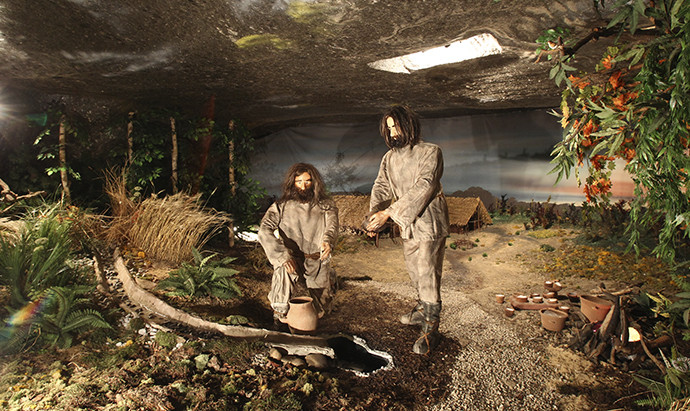
11th to 13th century

At the turn of the 11th and 12th centuries, when the salt springs began to weaken and disappear, an active search for brine was started through the construction of wells. Salt water was extracted from the well to the surface, and then boiled in iron pans until the pure evaporated salt remained. At that time, the whole region of Wieliczka developed, there were three residential settlements, two stone churches, trade and craft flourished.
In the 13th century, while one of the saline wells was being dug, the first lumps of rock salt were accidentally found. The discovery of the valuable raw material turned out to be revolutionary. It made it possible to obtain salt by mining methods – the first shaft leading underground was struck as early as the second half of the 13th century. Who did this? The latest research suggests that the extraction was carried out by local specialists, but the technological knowledge was brought from Western Europe.
14th to 15th century
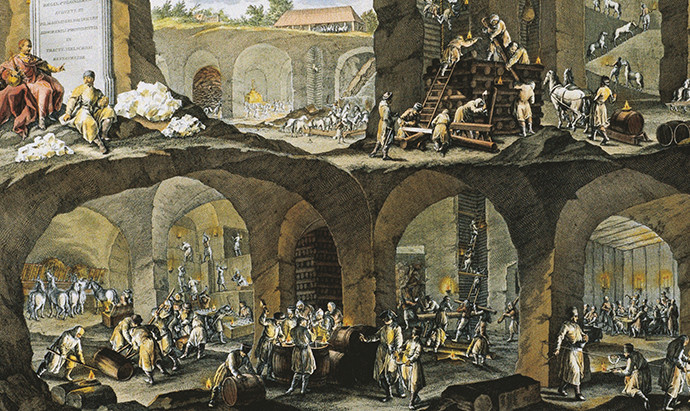
Casimir III is the only Polish king who was given the moniker Great by his descendants. This was not a coincidence! It is said about him that he found a Poland made of wood and left it made of stone. Rarer mention is made of the fact that he could not have done this if it had not been for the revenue from the salt extraction, which then constituted as much as 1/3 of the royal treasury’s income. The high profits from salt mining enabled him, among other things, to found the Krakow Academy – the first university in Poland. The same ruler issued the Saltworks Statute in 1368, ordering the old mining laws and traditions, which guaranteed the Mine’s stable development for decades to come.
At the end of the Middle Ages, 300–350 people worked in Wieliczka, and the annual production of salt reached 7 000 –8 000 tonnes. Although it is difficult to overestimate the importance of salt mining for the medieval Polish economy, in retrospect we know that in comparison with subsequent epochs, the medieval mine was not yet operating on a maximum scale. Mining was still seasonal, and the mine was open only in the months when no agricultural works were carried out. Until the end of the 15th century, there were only four mining shafts and one underground level in the mine.
Wieliczka had already gained fame and renown, and the first visitors descended to the underground. The first tourist whom we know by name was Nicolaus Copernicus. He probably visited the mine in 1493, and in remembrance of this event, a monumental salt figure of the brilliant astronomer was set up in a chamber named after him. You can admire it while walking along the Tourist Route.
16th to 18th century

These three centuries became a time of dynamic change. The mine moved to a year-round working schedule. The development required the employment of more and more specialists in various fields – e.g. surveyors, responsible for conducting detailed measurements. The first maps of the underground were created at that time. Listed among the most famous cartographers in Wieliczka are Martin German – author of the first preserved maps from the 1630s and Johann Gottfried Borlach, who created maps and was also one of the best managers of the company. In the 16th century, the search for salt below the first level began, and in the middle of the 17th century, the mine reached the third level.
Rock salt was not the only main source of income at that time. A large amount of salt was also produced in saltworks on the surface, where brine was evaporated in special pan furnaces. Due to the huge scale of production in the vicinity of Kraków, a shortage of firewood occurred, which led to the import of this raw material. When this turned out to be too troublesome, the salt water was simply transported even to very distant cities, such as Toruń, to convert brine into salt there. The lack of lumber also made it difficult for the miners to work because they could not build box cribs, the wooden structures that secured the underground workings. Finally, in the face of these complications, in 1724 salt evaporation was abandoned and only mining methods were used.
Every traveller who wanted to visit the underground had to obtain a personal royal permit at that time. Despite this, the number of tourists grew steadily, and mentions of Wieliczka appeared more frequently in European literature. The accounts of eminent scientists, travellers and diplomats presented the Mine as a unique and important place.
The Partitions

In 1772, the first partition of Poland took place. Three neighbouring superpowers, Russia, Austria and Prussia, took control of part of the Commonwealth, leading to the shifting of borders. Wieliczka came under the rule of the Habsburg Monarchy.
Despite the lack of a Polish state, the Mine continued to develop. The new owners planned the long-term development of the company and did not spare money for security, paying great attention to the technical condition of the equipment. Salt extraction using gunpowder was started, a railway line was built underground, a steam hoisting machine and a power plant were commissioned, and the production of salt resumed in a modern saltworks.
The attention that the Austrians paid to the Mine was not accidental at all. “Wieliczka” was the largest production plant in Galicia at the time, and one of the most important companies in the entire empire.
The new managers were also able to take advantage of the great interest in the Mine. During this period, tourism became an important source of income for the company. Many investments were made in order to increase tourism and various services were offered. From 1868 on, part of the route could be toured by horse-drawn railway. Breath-taking attractions were prepared for the guests, such as the devil’s drop – the miners’ descent into the mine using a rope. Boat rides on the saline lake were organised. During the tour, the path was illuminated with torches, the mining orchestra played for the visitors, and there were also fireworks shows.
In 1774, guest books were introduced to be signed by visitors. They have been preserved to this day and are a valuable historical resource – thanks to them, we can learn about the tourist traffic of old and follow its growth in the following decades. While at the end of the 18th century, the number of guests reached several dozen a month, at the beginning of the 20th century, it was as high as a hundred people a week. Visitors at that time were burghers – wealthy merchants and high-ranking officials, secular and clerical magnates, members of aristocratic and royal families.
A separate category of tourists at that time were Poles coming here from all three partitions. The Mine – the largest enterprise of the former Commonwealth – was a symbol and monument of the former glory of the nation. Wieliczka was visited “to fortify hearts” and the visit was a kind of political manifestation, a patriotic act and a testimony of attachment to national values.
The interwar period

After the end of the World War I and the regaining of independence by Poland, the mine once again became the property of the Polish State Treasury and was taken under Polish administration. It was a long-awaited moment, for which the inhabitants of Wieliczka and miners working underground had waited for about 150 years. The names of the shafts and excavations were symbolically changed at that time, e.g. Empress Elisabeth’s Shaft was renamed to St Kinga’s Shaft.
In the interwar period, salt production and trade were a very profitable enterprise, with annual production of 203,000 tonnes at peak times. The interwar period was a period of stabilisation for the mine, bringing the introduction of further development and expansion of the mine as a production plant, but also development of its tourist and therapeutic function.
During the interwar period (1918–1939), the Wieliczka underground was visited by about 120,000 people. A novelty at that time was the organisation of various events in the Mine, particularly rallies, conventions, anniversaries. Continuing the tradition of the First Republic, many distinguished guests from abroad were invited underground: rulers, high-ranking politicians and diplomats, to boast about the size of the company to them.
After 1945
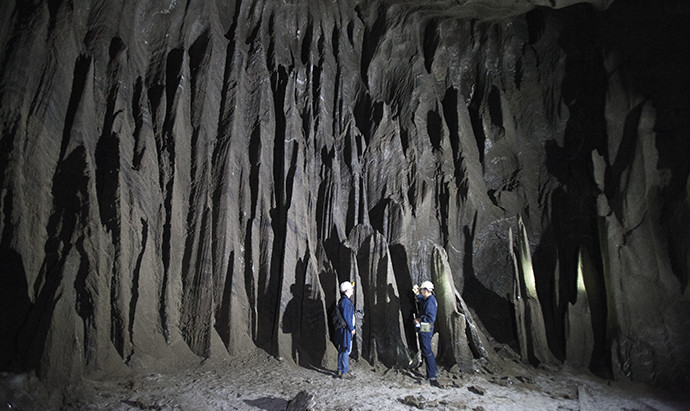
Shortly before World War II, a system of leaching – obtaining brine by dissolving salt rocks with water – was developed. After the war, the miners returned to using the system. After the World War II, which was marked in the history of the mine by intensified excavations, a very difficult time for the mine occurred, because the 1940s and 1950s were characterised by an increase in production regardless of the cost, without taking care to secure the workings.
At that time the plant developed very dynamically and in two ways. Salt production increased steadily and reached its maximum level in the 1970s. Tourist traffic was becoming more and more important, and the awareness of the cultural significance of the site was growing. The idea that preserving the Mine for future generations could be a task of much greater importance than industrial salt production and current profits was slowly taking root.
Eventually, the mine grew to nine levels, with a maximum depth of 327 metres. In 1964, the mining of rock salt in Wieliczka was completely discontinued in favour of the industrial production of evaporated salt using the wet mining method. The year 1978 proved to be important for the contemporary history of the mine, bringing the addition to the UNESCO World Cultural and Natural Heritage List, as did the year 1992 (water leakage in the Mina Crosscut). These events have shown that the historic mine is a priceless monument that requires special care and protection. In 1996 a decision was made to end industrial salt production in Wieliczka. Since 1976, the underground Wieliczka has been listed in the register of monuments, and in 1994, it was declared a national Historic Monument by the President of the Republic of Poland.
The Mine today
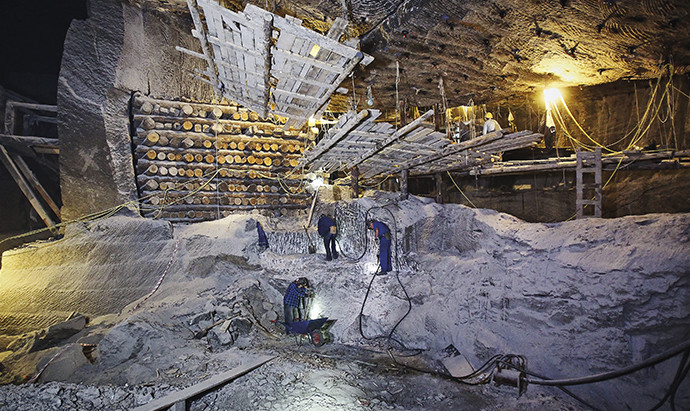
Cessation of production does not mean that miners no longer work underground. On the contrary! Every day, several hundred miners make sure that the Mine is a safe place and that it survives in the best possible condition for future generations. Miners protect the historic areas of the Mine, backfill in the so-called post-mining voids in its non-historical parts, as well as manage fresh water leaks. New attractions for tourists are also constantly being prepared – historic chambers, corridors and shafts are being renovated.
Throughout history, the way of thinking about the “Wieliczka” Salt Mine has changed from an industrial plant to a world-famous tourist attraction, a place of unusual events and a health resort.
Even today, the Wieliczka salt mine is often included in the plans of official visits of politicians, crowned heads of state and members of royal families. Kings and queens, princes and princesses, state leaders, artists, scientific authorities wander along the mine galleries and unanimously proclaim it beautiful, amazing, one of the wonders of the world. The salt underground is visited every year by nearly 2 million visitors from all over the world.
Discover the secrets of the underground world
Choose the Tourist Route if you want to discover the secrets hidden deep underground. Check out what the Wieliczka Mine has to offer to millions of visitors from all over the world.
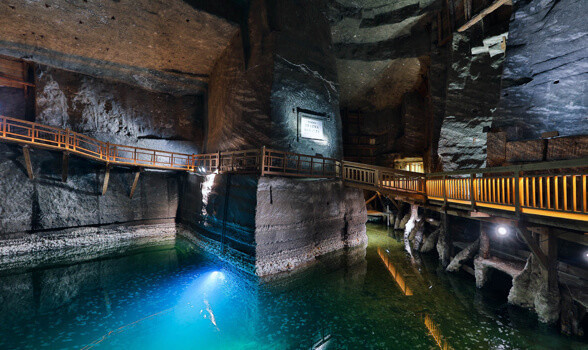
On the Tourist Route
You will admire landscapes that can’t be found on the surface: as saline lakes and beautiful underground chambers, including the unique St Kinga’s Chapel.
You will learn about old mining tools and machines and the methods of salt extraction and transport used in the past.
The tour is available for people of all ages and does not require above-average physical condition, but it is worth bearing in mind that there are more than 800 steps to climb.

Tourist Route by the numbers:
The Route in the structure of the Mine
The return to the surface is by lift from Level III (135 m).

- Daniłowicz Shaft
- Level I Bono – 64 m
- Level II upper – 90 m
- Level II lower – 110 m
- Level III – 135 m
Useful information Source : https://www.wieliczka-saltmine.com/individual-tourist/tourist-route
-
Starting point:
Daniłowicz Shaft -
Duration:
2 – 3 hours - Number of stairs to climb:
about 800 -
Reservation:
no -
Group size:
max. 35 people - Ending point:
Regis Schaft / Daniłowicz Shaft
You can buy tickets:
- at the Mine’s website
- at the ticket machine located at the entrance to the “Wieliczka” Salt Mine, on the opposite side to the Daniłowicz shaft
- at the ticket office in the Daniłowicz Shaft – provided there are tickets available, which were not purchased on-line.
Open flames, electric torches, smoking cigarettes (including e-cigarettes) are prohibited in the mine.
Tour organisation
Starting point:
Daniłowicz ShaftDuration:
2 – 3 hoursGroup size:
max. 35 peopleMinimum age:
noneTemperature on the route:
17-18ºCDistance to walk:
approx. 3.5 km- Ending point:
Regis Schaft / Daniłowicz Shaft
- Opening hours
The opening and touring times depend on the day you wish to visit the mine.
You can check the details here.- Guide
The tour always takes place under the supervision of a guide.
- Touring languages
The tour is available in Polish, English, German, French, Italian, Russian, Spanish and Ukrainian
- Starting the tour
The assembly point is the Daniłowicz Shaft, which the tourists then use to go down into the salt underground. Tours with Polish-speaking guides, as well as with guides speaking languages other than Polish take place at designated times, subject to the availability of tickets on-line.
On the route
Route characteristics
Beautiful chambers carved in salt, including the most exceptional one – St Kinga’s Chapel, amazing underground lakes, majestic carpentry structures and unique salt sculptures. Nearly 3 kilometres of winding galleries, 800 stairs to climb and a descent to 135 metres underground. No wonder that the charms of the Tourist Route, the main route of the “Wieliczka” Salt Mine, are admired by millions of adventure-seeking tourists from all over the world.
*In exceptional cases, some of the chambers on the Tourist Route may be excluded from the tour.
For the safety of our visitors, we have excluded some of the workings along the Tourist Route from the tour. The course of the tour will be continuously adjusted to the intensity of tourist traffic.
The Mine is a place where you can quiet down for a while and cut yourself off from the world, because telecommunication signals will not reach you here.
However, we have prepared a place for our guests where they can use free WiFi, as well as make calls.
The maximum depth you can reach is 135 m.
Safety
- Terms and conditions of touring
Detailed terms and conditions of touring the “Wieliczka” Salt Mine can be found here.
- Prohibitions
Open flames, electric torches, smoking cigarettes (including e-cigarettes) are prohibited.
Bringing animals in is prohibited, with the exception of service animals.
We do not offer a facility where you can leave your pet.- #safemine
- We placed dispensers with disinfectants in many places within the safe zone, as well as in the underground of the mine. You can find more information about the s






